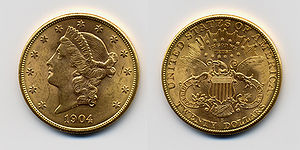The 1933 St. Gaudens Double Eagle $20 coin is perhaps the most famous single US coin in the world. It fetches virtually unheard of sums and draws the attention of the government whenever one is found. The FBI and CIA may be involved if you happen to find one of these coins. Now, why would it draw such attention and risk? Well...
For most of its history, the United States had always produced gold coins as part of its regular minting. Though the dawning of the Great Depression brought about a financial lurch. In an attempt to help ease the effects of the depression, the US congress passed the Gold Reserve Act in early 1934. The purpose of the act was to nationalize all gold and required banks to turn their gold reserves over to the federal government in exchange for notes of equal value.
The Double Eagle coin (worth $20) was first minted in 1849 with proof forms. The coin was issued in 1850 and produced all the way until 1933. The first design was the head of Lady Liberty with a coronet on the obverse, the reverse had a bald eagle with a shield in front of it and the words "IN GOD WE TRUST" right above the head of the eagle and the mintmark below it. It should be noted that, for the first few years of its existence, the motto was not present. The coin was designed by master engraver James Longacre.
In the early part of the 20th Century, president Theodore Roosevelt requested that a personal friend of his, Augustus Saint-Gaudens, be allowed to design a coin without approval from congress because Roosevelt felt that coins at that time were "hideous." Using his authority, Roosevelt managed to not only convince Saint-Gaudens to redesign the $20 Double Eagle coin, but to actually get it into production with very little input from anyone else.
The St. Gaudens coin is widely considered to be one of, if not the, most beautiful coin ever produced by the US Mint. It consisted of Lady Liberty, representing Victory, on the front, boarded by numerous stars with low-horizon sun rays beaming up from behind her. The reverse was simple and consisted of a bald eagle in mid-flight with the sun below it. The mintmark sat beneath the date. Originally, the date was on the reverse in Roman Numerals.
First minted in 1907, the St. Gaudens Double Eagle was rarely circulated due to its high value ($20 being worth a couple hundred in spending power today) and was not minted in large numbers, ranging between a few hundred thousand to a couple million each year. It would continue to be minted until 1933.
At the end of the 1920s, the stock market crashed and launched the Great Depression. The government began to pull out all the stops and ordered the nation off of the gold standard. In 1933 tens of thousands of Double Eagles were minted. Though, when Franklin D. Roosevelt came into office, he ordered that none of the coins be made available for sale. At the time, the cashier of the Mint, Harry Powell, began to sell some of the coins off to banks and collectors. It was ruled that banks were to trade in all of their gold and golden certificates for paper money and, within the year, all Americans were required to return all gold coins and certificates in exchange for paper money.
It is estimated that fewer than two dozen 1933 Double Eagles are in existence and only a handful have ever been accounted for. Just after the ban on the coin, the secretary of the mint allegedly had more than five individual specimens in his position. During the early-to-mid 1940s, a couple of the coins were sold off by a prominent coin dealer and the issue regarding these coins were brought to the Mint's attention.
The Mint had no records of ever issuing the coins out and, because of that, declared that all remaining specimens were acquired by illegal means. The Secret Service was tasked with finding all specimens and melting them down. Two specimens were donated to the Smithsonian Institute by the federal government and can still be found there.
Though the history of the most prolific of these Double Eagles isn't completely known; what is known that one coin made it into the hands of Egypt's King Farouk I. When the king passed away in 1965, the coin went missing once more before being brought back to the US in the late-1990s. The Secret Service seized the coin and, after a legal battle, it was decided that the coin would be put up for auction legally and the amount it would go for would be evenly split between the US government and the private owners. In 2002, the coin was sold for a record-shattering $7,590,020 at a Sotheby's auction.
Just recently, 10 specimens of the coin were sent to the Philidelphia Mint for verification where they were indeed verified and subsequently seized. The case is still pending and the trial should begin in July of this year.
The St. Gaudens Double Eagle coin is indeed a very sought after coin, thanks to its design, history and the sudden end of production that lead to a massive meltdown, keeping on a very, very small quantity of coins in private hands. It's definitely a very rare coin and I am sure we will hear of more of them being found in the future.
Though I do want to note, I personally don't think it's the most beautiful coin in US history. I still think that a proof Morgan Silver dollar is much more aesthetically appealing. Though I won't lie... Gold is much prettier than silver.

